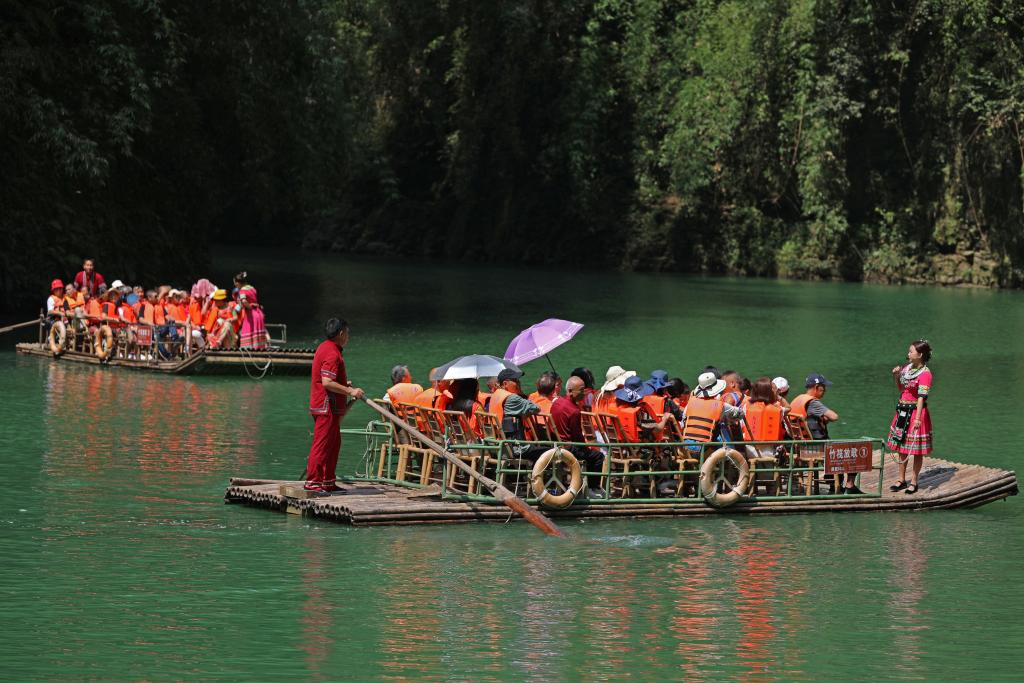County boosts ecotourism potential with afforestation


Sustainable Development Goals (SDGs) and Ecotourism in Ayi River Community

In 2013, Wang Minggang, a native of Pengshui Miao and Tujia autonomous county in Chongqing municipality, decided to return to the Ayi River Community in his hometown after years of migrant work elsewhere.
Wang had two reasons to head back — to help beautify the local rocky environment and to be close enough to take care of his children and elderly parents.
He rented 300 mu (20 hectares) of undeveloped land in the Yantouba area of Ayi River Community Group 6 to develop an ecological agricultural business.
Nestled within the Wuling Mountains, Ayi River Community in Shaoqing subdistrict is characterized by high mountains and steep slopes, with a smattering of workable farmland.
Restoration and Sustainable Development
- As one of the 100 key counties for comprehensive rocky soil/desertification control in China’s karst areas, Pengshui started to restore and construct forest and grass vegetation since 2011 in its karst areas, covering 3,437 square kilometers.
Success in Ecological Agriculture
- After years of development, Wang’s ecological orchard now boasts 12 types of fruit products certified as green foods, with annual fruit sales nearing 2 million yuan ($281,600).
- During the peak tourist season between May and October, the orchard hosts more than 300 visitors daily, and also offers jobs for nearby villagers.
Transformation through Ecotourism
- At Hujiawan Miao village in the Ayi River Community, Yang Caijun said ecotourism has completely changed the village.
- Back in the 1980s, nearly half of the villagers were engaged in mining, and Yang himself was among them.
- “The mining activities often filled the area with dust, affecting Ayi River’s ecological environment. But by 2017, all the mining enterprises around Hujiawan were shut down, and the ecological environment has turned for the better,” he said.
- Tuo Zhenping, Party secretary of Ayi River Community, said that since 2022 villagers in Hujiawan began to pay more attention to developing the ecotourism sector.
- “During the peak season, many residents earn over 10,000 yuan a month just by selling tourism-related products,” Tuo said.
Enhancing Ecological Conservation
- Zhang Yao, a 38-year-old employee at Ayi River Scenic Area’s Visitor Reception Center, said she has witnessed the entire process of Ayi River’s development into a national 5A-level tourist attraction.
- Though visitors can often find “a new view with every step” along the river, initial expert evaluation said “the ecological resources are rich, but there is a lack of planning and management”.
- Tian Chuan, a manager at Ayi River Co, said the scenic spot has intensified efforts in vegetation care and the protection of rare flora and fauna in recent years, solidifying its foundation for developing ecotourism.
Progress towards Sustainable Development
- Currently, Pengshui has completed 7,740 hectares of artificial afforestation and 829 hectares of protected afforestation, helping enrich local residents and beautify the ecology.
- In recent years, Pengshui has strived to become a model for distinctive, green ecotourism development. In the first half, the county’s tourist visitor numbers and comprehensive tourism revenue increased by 20.8 percent and 24 percent, respectively.
SDGs, Targets, and Indicators
-
SDG 15: Life on Land
- Target 15.1: By 2020, ensure the conservation, restoration, and sustainable use of terrestrial and inland freshwater ecosystems and their services, in particular forests, wetlands, mountains, and drylands, in line with obligations under international agreements.
- Indicator: The restoration and construction of forest and grass vegetation in Pengshui’s karst areas since 2011.
-
SDG 8: Decent Work and Economic Growth
- Target 8.9: By 2030, devise and implement policies to promote sustainable tourism that creates jobs and promotes local culture and products.
- Indicator: The development of ecotourism in Ayi River Community, leading to job creation and increased income for residents.
-
SDG 11: Sustainable Cities and Communities
- Target 11.4: Strengthen efforts to protect and safeguard the world’s cultural and natural heritage.
- Indicator: The intensified efforts in vegetation care and the protection of rare flora and fauna in Ayi River Scenic Area.
Table: SDGs, Targets, and Indicators
| SDGs | Targets | Indicators |
|---|---|---|
| SDG 15: Life on Land | Target 15.1: By 2020, ensure the conservation, restoration, and sustainable use of terrestrial and inland freshwater ecosystems and their services, in particular forests, wetlands, mountains, and drylands, in line with obligations under international agreements. | The restoration and construction of forest and grass vegetation in Pengshui’s karst areas since 2011. |
| SDG 8: Decent Work and Economic Growth | Target 8.9: By 2030, devise and implement policies to promote sustainable tourism that creates jobs and promotes local culture and products. | The development of ecotourism in Ayi River Community, leading to job creation and increased income for residents. |
| SDG 11: Sustainable Cities and Communities | Target 11.4: Strengthen efforts to protect and safeguard the world’s cultural and natural heritage. | The intensified efforts in vegetation care and the protection of rare flora and fauna in Ayi River Scenic Area. |
Source: chinadaily.com.cn








